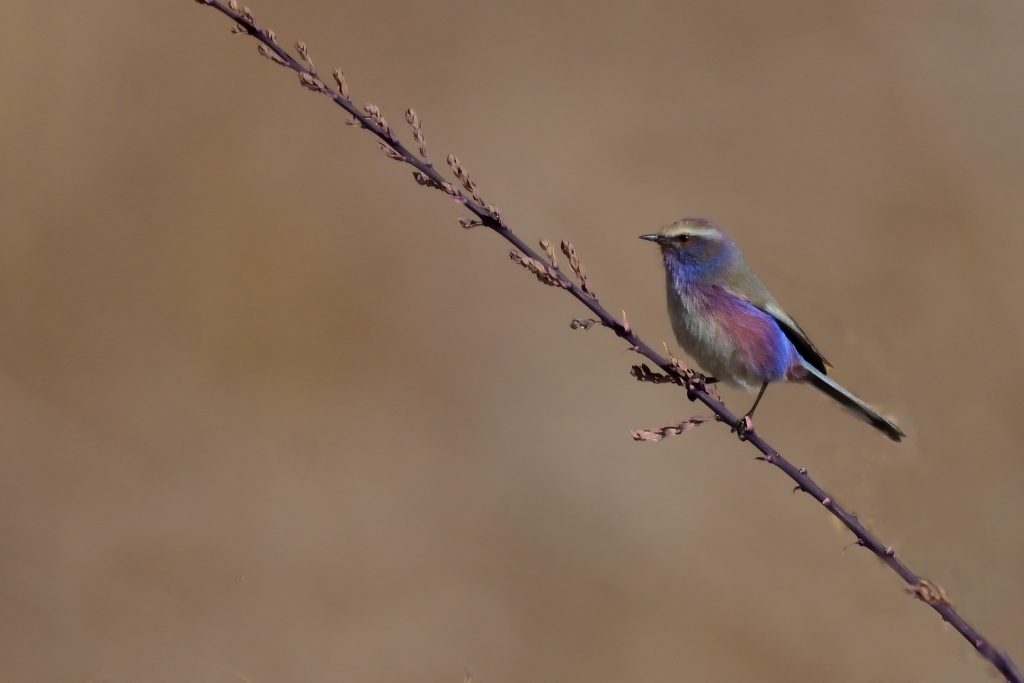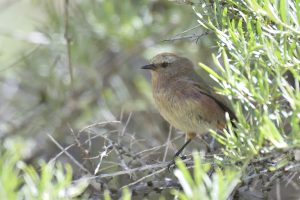White-browed Tit Warbler

Male, Ladakh
Scientific Name- Leptopoecile sophiae
Subspecies in India- L. s. sophiae- NW India (Ladakh) and L. s. obscurus- S and E fringes of Tibetan Plateau
IUCN Category- Least Concern
Habitat-Montane forest, scrub and thickets. In Kazakhstan, breeds from upper margins of spruce (Picea schrenkiana) forest zone to upper limit of juniper (Juniperus) scrub at c. 2200–3200 m, but optimally in fairly narrow altitudinal band where juniper scrub best developed (c. 2500–2900 m); scrub mainly prostrate form of Juniperus turcestanica, in scattered clumps on steep (up to 45°) slopes, or (mainly on S-facing slopes) in impenetrable thickets. In non-breeding season found below spruce zone and into foothills, where frequents thickets of rose (Rosa), Prunus, Elaeagnus and willow (Salix) and occasionally tall herbaceous vegetation, often on S-facing slopes and in scrub by water; sporadically in gardens, parks and roadside trees. In W Tien Shan, winters in thickets of sea-buckthorn (Hippophae rhamnoides), Elaeagnus, tamarisk (Tamarix) and Ephedrum in river valleys, sometimes (when much snow in valleys) on plains at 400–450 m. Elsewhere in range, breeds in dwarf scrub (perhaps especially Juniperus, Berberis and Caragana) above tree-line in dry mountainous areas (e.g. in Himalayas found in more arid, rain-shadow regions and may have preference for drier S-facing slopes). In N Indian Subcontinent breeds at 3000–3900 m in Pakistan and India and recorded at 2700–4575 m (probably breeding mostly above 3500 m) in Nepal; in winter down to c. 1800 m (seldom lower), and favouring, where available, valley-bottom thickets (especially Hippophae rhamnoides, Astragalus and Phragmites). In China recorded at 2700–5000 m, in Nan Shan (Gansu) common throughout subalpine belt at 3000–3600 m from upper limit of forest through Caragana jubata zone to uppermost juniper scrub; in Xining region (Qinghai) breeds down to 2700–2600 m, where Berberis predominant; in Xizang found at 3500–5000 m.

Male, Ladakh
Food and Feeding- Diet small insects and spiders (Araneae); also, mainly in autumn and winter, small quantities of seeds and berries, e.g. one individual in Jun had stomach filled with juniper scales. Nestlings probably fed entirely with insects and spiders. Forages among herbs and shrubs, where very active and agile; sometimes forages on ground, investigating root tangles and lichen-covered rocks. Sometimes catches insects by aerial flycatching. In family parties after breeding season, these sometimes amalgamating to form flocks of up to 25 or more individuals; in winter months may join mixed-species foraging flocks.
Breeding- Data mostly from Tien Shan. Laying about mid-May to mid-Jun, with replacement clutches possible until late Jul (early nests, complete in Apr, may remain empty for nearly a month); single-brooded. May form permanent pair-bonds or pair in autumn (usually seen in pairs in winter and early spring). Records of several nests in close proximity (sometimes two or three side by side), leading to suggestions of possible colonial breeding, but extra nests may be used as overnight roosts. Two females attending a single nest, with a brood of normal size, and egg dumping by an additional female, have both been recorded in S Tibet. Nest built by both sexes, work divided equally (although male may take main part in provisioning material, female in building), taking 6–8 days for framework and almost as long for lining; an oval ball c. 130–155 mm × 90–120 mm, walls up to 30 mm thick, floor up to 35–40 mm deep, circular entrance 28–35 mm in diameter on one side towards top, outer layer of coarse material such as large pieces of moss, thin stalks, spider cocoons, lichen and plant bast, inner layer of same material as well as plant hair, wool, dead leaves, feathers and the like, and lining mainly of feathers, in Tien Shan downy feathers from Himalayan Snowcock (Tetraogallus himalayensis) and Chukar (Alectoris chukar) favoured, in other parts of range (including China) those of Blue Eared-pheasant (Crossoptilon auritum), shape of feathers makes them stick up in nest and they thus form “elastic funnel” at entrance (when adult enters, entrance closes behind it); some nests have very few feathers and are lined instead with sheep’s wool, or with plant down and marmot (Marmota) hair mixed with small amount of wool and feathers; nest usually very well concealed in scrub (in Gansu typically Caragana jubata), in Tien Shan 55–56% of nests were 0·5–1·9 m up in Juniperus turcestanica, usually in upper part of bush, supported by small branches at sides and base, with walls woven around larger branches, 33–36% were 2·5–15 m up in Picea schrenkiana, placed close to trunk on horizontal branch or 1·5–2 m from trunk and woven together with thin hanging twigs/branches (thus suspended like nest of Regulus); spruce may be preferred if available, and honeysuckle (Lonicera) occasionally used but only for replacements. Clutch 4–8 eggs, white, spotted and flecked light brown and reddish-brown, c. 15·5 × 11·7 mm (nominate race); incubation by both sexes, period 14–17 days (usually 14–15 days); both sexes brood chicks for first c. 7–8 days, and roost in nest with them; young leave nest at 18–20 days (sometimes to 23 days), but remain close to nest and roost there for 7–12 days after fledging. In a study in the alpine zone of S Tibet, clutch size 4·7 eggs on average (n = 102) and brood size 4·3 at hatching and 3·8 at fledging; 66% of observed nests (n = 108) fledged at least one young.

Female, Ladakh
Status and Conservation- Not globally threatened (Least Concern). Locally common, but absent from some apparently suitable areas (e.g. Talasskiy Alatau). Possible occurrence (presumably of race obscurus) in NE India, where reported sightings in NW Arunachal Pradesh, merits further study. Marked fluctuations in numbers noted in C Asia, e.g. in Almaty area of Kazakhstan very common in 1960s but almost none in 1970s, perhaps owing to high mortality in hard winter of 1968/69; densities of c. 1 pair/1–2 ha of habitat have been reported in same region. There is good evidence for a decline in Kazakhstan, where now listed as rare. Throughout range, species is vulnerable to degradation or destruction of breeding habitat by overgrazing.
Reference- HBW
